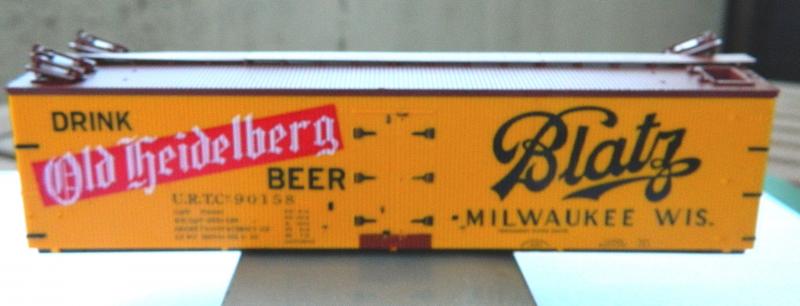Weights in freight stock
Posted
#196455
(In Topic #10896)
Full Member
Nuts, no bolts
Hi All,The following may be useful. I build Branchline kits whenever I can get them at a show or exhibition, North American outline - freight cars, 'reefers' (refrigerated freight cars, ice or mechanical), Pullman heavyweight passenger cars. Nicely detailed and fun to build.
The freight stock kits used a weight method that is simple and can be applied to UK and North American freight cars and vans, and with some cover to open wagons. The system used stainless steel nuts, 3/4" diameter, and these are readily available at my local hardware store (4 for $1.00). The kits recommend CAA, I decided to use marine-grade clear silicone sealant used for boats, etc., but regular bathroom silicone sealant should be fine Keeps the weight in place, dries in about 3 hours, and can be easily removed by peeling-off the silicone. I also use the silicone sealant for flat steel weights if they are supplied with a kit. Some manufacturers kits have no weights (or trucks/bogies/wheels) so this is my method of choice. Any excess silicone can be trimmed off with a sharp blade. Should be good for 10+ years (the life of the silicon sealant).
Photos below of a 1920's "Billboard" reefer for a long-forgotten Midwest beer that I'm currently building. No tripod, taken outside, focus a bit off on the first photo.
Nigel

1920's 'billboard' reefer. Presumably getting blitzed on Blatz was a prime moving force for abolition. Hatches at the ends were where the ice went to keep everything cool.

3/4" stainless steel nut weights in place with silicone sealant. They are mounted over the wheel bogies for maximum adhesion. Using a blob of silicone means that the the nut is actually threaded into the silicone. For a 4-wheel van or small tender mount them in the middle. Larger vans (parcels) or tenders mount them at the ends. Fortuitously 2 of these will bring the weight up to NMRA practices. If a bit of adjustment is required I used stainless steel washers on top of the nuts and a smear of silicone. Darned sight easier than CAA to get silicone off my fingers and unlike CAA it doesn't damage paint or plastic!

Last photo shows the fine-scale medium length center-set Kadee coupler and the air-line hose supplied with the kit. The trip pin is supposed to represent the air-line hose, it will be removed, as I do not use magnetic delayed uncoupling with my North American stock.
 Last edit: by BCDR
Last edit: by BCDR
©Nigel C. Phillips
Posted
Banned

Cheers, Gary.
Posted
Full Member
2 years in and no nuts rattling around so far. Which is more than can be said for glued weights. I used to use plumbers lead sheet, but found that unless the surface was really cleaned of oxidation the adhesive (whatever it was, Gorilla is probably the equivalent here) set to the oxide coat, not the metal.
I had to look up Tarzan's Grip - "…and it has been estimated that fifteen percent of the earth's land fill is comprised solely of once-used, and useless, tubes of Tarzan's Grip." Good for sales though.
A bit like the tubes of silicone I use unless they are well sealed.
Nigel
©Nigel C. Phillips
Posted
Full Member
There is an NMRA standard for weighting rolling stock - I have it somewhere but Sol's the brains who knows what it is. Most of the RTR stuff nowadays is far too light because they use plastic rather than diecast chassis. My problem is, where on earth do I put the weights on an open coal truck (wagon) ?
Gary, you've really confused me now - why would an elephant want a piano accordian stuck to it's a#se ? Surely it would break when it sat down ………. or is that how they create "flat" notes …………:hmm
'Petermac
Posted
Guest user
Posted
Full Member
'Petermac
Posted
Site staff

Ron
NCE DCC ; 00 scale UK outline.
NCE DCC ; 00 scale UK outline.
Posted
Full Member
Coal wagons. Empty is a problem, although many when "empty' has a small pile at either end. One of the few places I would use lead shot (recycled these days), or just use a sheet cut to the dimensions of the floor and suitably scored to represent planks. Silicone sealant, not CAA, to fix in place.
I recently refurbished some Pullman Palace cars (heavyweight clerestory passenger) that came with recycled car wheel lead weights used for balancing. Double NMRA weight recommendations. They now have nuts at either end in the toilets.
Nigel
©Nigel C. Phillips
Posted
Full Member
They come in strips with 10gm/5gm/10/5/10/5. They also have double-sided adhesive pads.
The weights are small enough to be attached out of view.
Foster :hmm
Posted
Full Member
Also found in the model railroad world, only in quarter and half ounces. You can get them in steel as well, much more health friendly.
Nigel
©Nigel C. Phillips
Posted
Full Member
Cheers,
Martin
Manifestly it is better to use simple tools expertly than to possess a bewildering assortment of complicated gadgets and either neglect or use them incompetently. ( L.T.C.Rolt)
Posted
Full Member
Posted
Inactive Member
I use bits of lead strip because I have a pile, though as i'm about to ballast, my 305mm to the foot 16ft keelboat that stock will reduce dramatically.
Im not sure it needs to be Stainless, but buying four nuts at a time is an expensive way of doing it,. Buying a pack of 100 is much more economic long term.
Now I've finally started a model railway…I've inherited another…
Posted
Full Member
I use the thin lead flashing used for roofing - cut and bent to fit - and then fixed with a hot glue gun.
Horses for courses.
Gary
__________________________________________________
I am no expert but I do what I can, when I can, with what I can.
__________________________________________________
I am no expert but I do what I can, when I can, with what I can.
Posted
Full Member
Hot glue works fine as long as the lead was nice and bright, if grey and oxidized the glue sticks to the oxide, and it will eventually detach. As will epoxy, CA, silicone,…
Advantage of the nuts is different weights with different sizes, and they work out cheaper then lead sheet and are far less toxic. Plus no oxide.
Nigel
©Nigel C. Phillips
Posted
Full Member
Gary
__________________________________________________
I am no expert but I do what I can, when I can, with what I can.
__________________________________________________
I am no expert but I do what I can, when I can, with what I can.
1 guest and 0 members have just viewed this.

